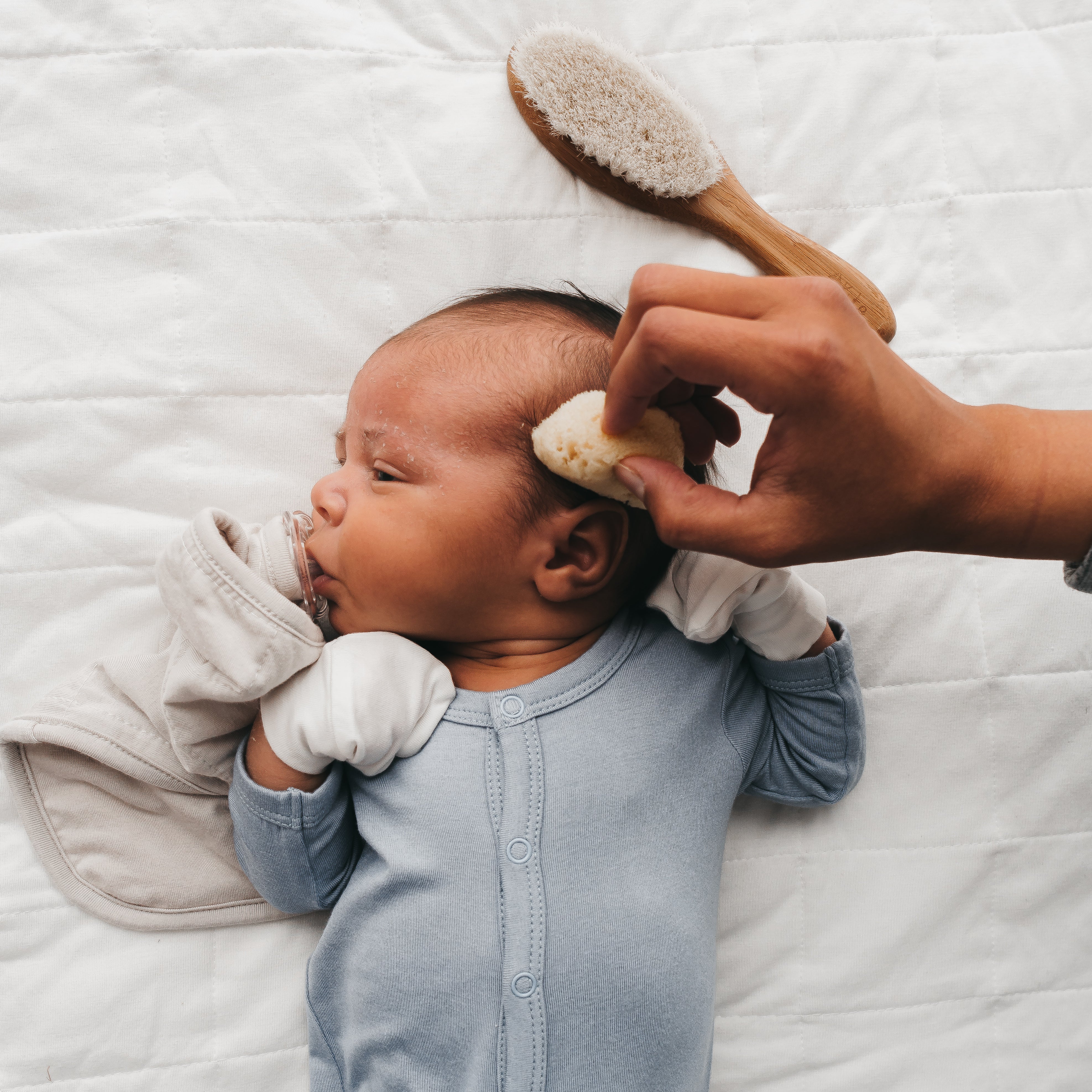
Having a newborn can turn our whole world upside down and the loss of control on our daily routines can keep us from enjoying our squishy new baby!
It is normal to try to control what we can, or feel like we can control something, and that can manifest in trying to use very strict/by the clock type schedules with our newborns for both eating and sleeping.
Unfortunately, our newborns did not read the same books we did so using a strict newborn feeding schedule is not really advised. It is much better to feed responsively so make sure to read more about what responsive feeding is and newborn feeding cues as opposed to a feeding schedule for newborn!
*Please note that if you have a premature infant, your pediatrician may advise a strict feeding schedule so this blog is aimed for term infants with no known health issues.
In this blog, we will cover:
-
What is responsive feeding
-
Newborn feeding cues
-
Sample routines by age
-
Newborn baby feeding schedule for breastfeeding, newborn formula feeding schedule, and combo feeding or supplementing
-
How to introduce a bottle
-
Pumping schedule including exclusive pumping

What is responsive feeding
Important things to note about responsive feeding: helps your child develop healthy eating habits, lowers the risk of becoming overweight, helps your child learn to feed themselves, makes meal time easier, and we can more easily bond with our child!
In order to practice responsive feeding, make sure your child is comfortable and minimize distractions, watch signs of hunger or fullness, respond promptly to their feeding cues (if she seems full, allow her to stop eating), focus on being warm and affectionate during feeding times.
Please remember that it is not the method of feeding that allows you to bond with your child, but the interaction during feeding! Warm, nurturing bottle feeding can from a more secure attachment and bond that tight, mechanical breastfeeding.
When your baby is full, he may start and stop eating often, unlatch often, spit out or ignore the breast or bottle, slow down/fall asleep, fidget or get distracted easily, turn away from the food source.
Relaxed and open hands are also a sign that baby is full!
Responsive feeding is so important so that we don’t override our babis internal hunger and fullness cues. It can also affect their ability to self-regulate or control his eating and emotions.
Newborn feeding cues
Newborns have early feeding cues, active feeding cues and late feeding cues. Typically, you want to try to catch the early feeding cues so that you have an easier time feeding your little one!
Some early feeding cues consist of: smacking or licking lips, opening and closing mouth, sucking on lips, tongue, hands, fingers, etc.
Some active feeding cues consist of: rooting around on the chest of whoever is holding them, trying to position themselves in a feeding position, fidgeting or squirming a lot, hitting you on your arm or chest, fussing or breathing heavy
Some late feeding cues consist of: moving head frantically from side to side and crying (red faced).

Sample routines by age
It is important to remember all babies are different―some like to snack more often, and others drink more at one time and go longer between feedings. However, most babies will drink more and go longer between feedings as they get bigger and their tummies can hold more milk:
- Most newborns eat every 2 to 3 hours, or 8 to 12 times every 24 hours. Babies might only take in half ounce per feeding for the first day or two of life, but after that will usually drink 1 to 2 ounces at each feeding. This amount increases to 2 to 3 ounces by 2 weeks of age.
- At about 2 months of age, babies usually take 4 to 5 ounces per feeding every 3 to 4 hours.
- At 4 months, babies usually take 4 to 6 ounces per feeding.
- At 6 months, babies may be taking up to 8 ounces every 4 to 5 hours.
Most babies will increase the amount of formula they drink by an average of 1 ounce each month before leveling off at about 7 to 8 ounces per feeding. Solid foods should be started at about 6 months old when signs of readiness are evident.
If you aren't sure how to incorporate a sleep routine for your newborn, check out this blog about baby bedtime routines!
If you have a really sleepy newborn that is difficult to wake for feedings, after you rule out medical reasons for that like jaundice, you can try an infant massage routine to help wake them up!
Newborn baby feeding schedule for breastfeeding, newborn formula feeding schedule, and combo feeding or supplementing
Establishing a newborn feeding schedule does not mean using rigid timetables or making sure they finish 4 ounces every single time.
Your baby should be fed every 2-3 hours, on demand with attempts to feed 8-12 times in a 24 hour period.
Generally speaking, a feeding may take 15-20 minutes though some babies may take a little bit longer to eat!
If you aren't sure what a sleep schedule looks like for a newborn, you can read about baby sleep schedules or how much newborns sleep!
Sometimes you may have a really fussy baby like during the baby witching hour and swaddling your baby may help them calm down enough to eat well!
A newborn feeding schedule when breastfeeding or formula feeding may look something like:
7:00am wake up and nurse/bottle feeding
9:30am wake up and nurse/bottle feeding
11:30am wake up and nurse/bottle feeding
12:30pm showing signs of hunger, rooting, so baby is nursed again/bottle feeding
3:30pm wake up and nurse/bottle feeding
4:45pm baby is beginning to fuss, chew on hands, so nursed again/bottle feeding
6:45pm wake up and nurse/bottle feeding
9:30pm nurse/bottle feeding and put down for bedtime
12:30am wake up and nurse/bottle feeding
3:30am wake up and nurse/bottle feeding
6:30am wake up and nurse/bottle feeding
That’s 11 feedings in 24 hours! Literally eating and sleeping around the clock.
If you are combo feeding or supplementing, you may offer a top off bottle after half of your feedings in order to get more ounces in or you may offer a bottle every other feeding/in the evenings instead of breastfeeding!
While we support the fed is best movement, we also suggest support is best! So any mom that is struggling with infant feeding, no matter how your baby is fed, surround yourself with resources in order to have a healthy feeding relationship with your baby.
How to introduce a bottle
If you’re a breastfeeding mom that needs to return to work or wants to introduce a bottle, you can do so early on in your newborn’s life. Most moms have the best results introducing a bottle earlier, rather than later.
Consider pumping after your first morning feeding as most moms are more “full” around that time. Remember that you are pumping leftovers so do not expect enough for a full bottle just yet!

Here are some tips to help you introduce a bottle to your newborn feeding schedule:
-
Choose a day/time that a support person can help in case your little one gets frustrated with you offering the bottle; sometimes moms have better luck than others though, so don’t be afraid to try!
-
Hold baby in a semi-upright position, head above stomach
-
Hold the bottle at an angle tilted just enough to fill the nipple to allow baby to keep control of when and how fast the milk comes.
-
Tickle the baby’s mouth to encourage an open mouth then bring baby up onto the bottle nipple, aiming the nipple toward the palate.
-
Some have found that it can help to have an article of clothing you have worn, like a nightgown or t-shirt, to place on their arm, shoulder, or chest where the baby can smell your scent.
-
Some may prefer different bottles, nipples, and flows so try 2-3 different ones (but don’t break the bank trying to find one they’ll take)
-
A lot of babies may prefer the milk to be warmer than even freshly pumped milk
-
If your baby refuses frozen milk, test for high lipase by smelling/tasting the milk. If it is metallic or soapy, you may have high lipase and your baby may not like the taste. You can try with fresh milk instead. (if you do have high lipase, you can scald the milk before freezing or add a drop or two of alcohol-free vanilla to the bottle)
-
Walk around with your baby. Can try bouncing, gently swaying with the baby.
-
Start by nursing the baby, then unlatch and replace with the bottle nipple.
-
Have some milk on the end of the bottle nipple and warm the nipple by running it under hot water if needed for a moment.
-
Try the bottle when your baby is sleepy.
-
Make sure the nipple hole is the right size. If your baby seems to be gagging or gulping too fast, the nipple hole may be too large. If your baby is sucking hard and seems frustrated, the hole may be too small.

You can read more about nipple confusion if you have any concerns in this literature review as well as this article!
Important note: Never warm a bottle of formula or human milk in the microwave. The bottle itself may feel cool while the liquid inside can be too hot. Microwaving also heats unevenly. Even though a few drops sprinkled on your wrist may feel OK, some of the formula or human milk may be scalding. The composition of human milk may change if it is warmed too much, as well.
Pumping schedule including exclusive pumping
If you are going to journey down the path of exclusively pumping, then it is definitely important to have a good quality double electric breast pump!
Because a newborn often eats every 2-3 hours on demand, most experts suggest it is best if mom can come close to matching what the normal nursing baby would do at the breast, and recommend she pump about every two hours, not going longer than three hours between sessions.
It is helpful to be on an opposite schedule of your newborn for pumping and feeding so that you are not having to constantly pump during or right after a bottle feeding for newborn. It’s safe to say feeding a baby in any way shape or form is a full time job!

It can be beneficial to pump after a few feedings during the day if you are trying to supplement breastmilk in a bottle or having some extra milk on hand when needed! Generally pumping after the first morning feed will yield the most output.
As always, the biggest takeaways from this article is that we respond to our infant’s feeding cues instead of trying to put them on a newborn feeding schedule (unless otherwise directed by a physician). Any method of feeding can help to foster your bond and attachment with your baby! Try to set aside distractions (like your phone or television) and devote that time to tuning into your little one.
AUTHOR: Ashley Olson is a certified pediatric sleep consultant, owner of Heaven Sent Sleep, and passionate about helping new parents, experienced parents, desperate and sleep-deprived parents form healthy sleep habits for their children.
She has over 3 years of experience in working with families and has completed over 150 hours of coursework plus continuing education related to infant and toddler sleep. The focus of her work is on fostering a routine that grows your bond with your child while improving their sleep habits. She specializes in custom sleep plans and one on one support in changing sleep practices!





















